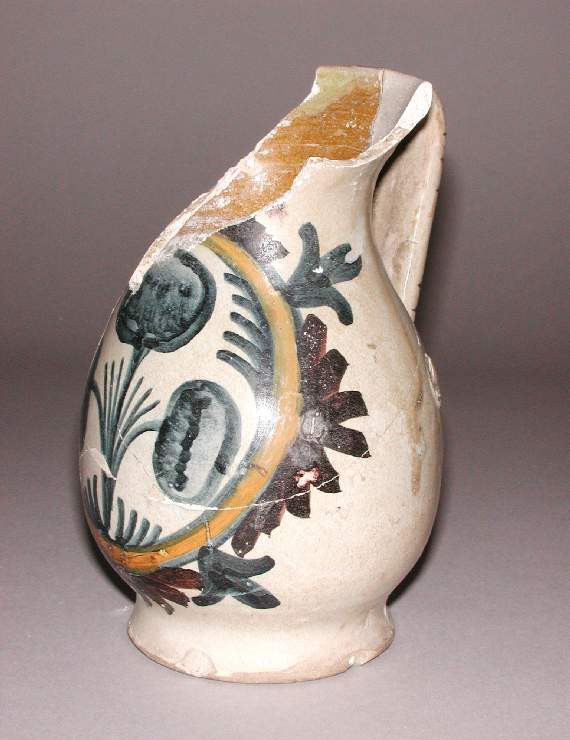Current Location: In storage
Maker(s)
Maker:
Unidentified Orvieto pottery
(Probably)
Entities
Categories
Description
Renaissance maiolica part of a jug, painted in blue, yellow and manganese with, on the front, a stylised plant framed by a band.
Buff earthenware, thrown. The interior is lead-glazed yellowish-brown; the exterior tin-glazed greyish-white with streaks of brownish-grey; base unglazed. Painted in dark blue, yellow, and dark manganese.
Piriform, with slightly projecting base and broad strap handle; the front of the neck and spout are missing.
On the front is a stylised plant with three oval leaves or fruits, framed by an oval yellow band between narrow blue, with alternating blue and manganese leaves round the edge. The handle has two groups of three horizontal blue stripes.
Notes
History note: Signor Avvocato Arcangelo Marcioni (1859-1928) or Cavaliere Capitano Ferdinando Lucatelli (1862-19 ); Sotheby's, 16-17 [17] February 1914, Catalogue of the collections of early Italian pottery formed by Signor Avvocato Marcioni and Cavaliere Capitano Lucatelli of Orvieto, part of lot 235A. William Ridout; Christie's, 13 December 1938, The William Ridout collection of Italian majolica, European pottery, faience and delftware, part of lot 33; H.S. Reitlinger; the Reitlinger Trust, from which transferred in 1991.
Legal notes
H.S. Reitlinger Bequest, 1950.
Measurements and weight
Diameter: 7 cm
Height: 14.4 cm
Acquisition and important dates
Method of acquisition: Bequeathed
(1950)
by
Reitlinger, Henry Scipio
Dating
15th Century, Late
16th Century, Early
Renaissance
Circa
1470
CE
-
1510
CE
Note
Plants with kidney-shaped leaves or pomegranates and fan-like shoots were common on central Italian jugs during the late fifteenth and early sixteenth century, and some are attributed to the Romagna or Marches. W.B. Honey attributed this example to Faenza. However, its provenance suggests that it is likely to have been made in Umbria, probably at Orvieto, but comparable jugs were also made in Lazio. A waster jug decorated witjh a similar two-leaved plant and frame was found at a pottery site adjacent to the Pozzo della Cava, in via della Cava, Orvieto, active from around the mid fifteenth to the early sixteenth century.
School or Style
Renaissance
Components of the work
Decoration
composed of
high-temperature colours
( dark blue, yellow, and dark manganese)
Interior
composed of
lead-glaze
Exterior
composed of
tin-glaze
Body
Materials used in production
Earthenware
Inscription or legends present
- Text: 235/5A
- Location: On base
- Method of creation: In pencil
- Type: Inscription
Inscription present: circular with blue border
- Text: 'WILLIAM RIDOUT COLLECTION' printed in blue, 'FA./6' in black ink
- Method of creation: Printed in blue and inscribed in black ink
- Type: Label
References and bibliographic entries
Identification numbers
Accession number: C.165-1991
Primary reference Number: 72392
Stable URI
Audit data
Created: Saturday 6 August 2011
Updated: Tuesday 30 April 2024
Last processed: Wednesday 14 May 2025
Associated departments & institutions
Owner or interested party:
The Fitzwilliam Museum
Associated department:
Applied Arts




